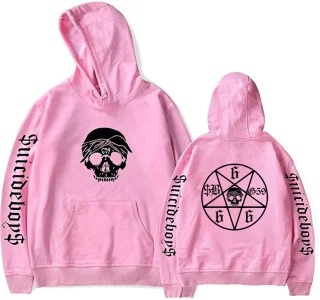$uicideboy$ Merch: The Role of Limited Drops in Reducing Waste
The $uicideboy$ brand is more than just a musical powerhouse; it’s a cultural phenomenon that bridges underground rap with streetwear fashion. Beyond the aesthetic appeal and emotional connection their merch offers, there’s an emerging conversation about sustainability in streetwear. Limited drops—where merchandise is released in small, exclusive batches—have become a strategic choice not just for maintaining hype, but also for reducing unnecessary waste. In an era where the fashion industry is one of the largest contributors to environmental damage, $uicideboy$ merch offers an interesting case study in how exclusivity can align with environmental responsibility.
Why Limited Drops Matter in Streetwear
Limited drops create urgency, exclusivity, and demand. But beyond marketing strategy, they directly impact how much clothing gets produced and discarded. Mass production often leads to overstock, suicideboys merch which may be sold at heavy discounts or destroyed entirely. By producing only what they expect to sell, $uicideboy$ and their partners avoid the excessive waste that plagues mainstream apparel production. This approach not only keeps the brand’s releases in high demand but also prevents unnecessary consumption of raw materials and energy.
Aligning with Sustainable Practices
In the traditional fast fashion model, companies prioritize speed and volume, leading to environmental harm. Limited drops turn this model on its head by emphasizing quality, thoughtfulness, and exclusivity. For $uicideboy$, each merch release is treated as a collectible moment rather than a disposable product. This intentionality encourages fans to cherish their purchases longer, reducing the likelihood of garments ending up in landfills. It’s a slower, more deliberate form of fashion consumption—one that resonates with a generation increasingly aware of sustainability.
The Emotional Value of Scarcity
Scarcity has psychological power. When an item is rare, it holds more value in the eyes of its owner. Fans who manage to secure a piece from a $uicideboy$ merch drop often develop a deeper connection to the product. This emotional attachment extends its lifespan—people are less likely to discard something they perceive as special. This means less turnover in wardrobes and fewer textiles entering the waste stream, subtly but effectively contributing to waste reduction.
Pre-Order Models and Waste Reduction
Some $uicideboy$ merch drops follow a pre-order model, allowing the brand to produce exactly the number of items fans have committed to buying. This eliminates the guesswork in inventory planning and drastically reduces leftover stock. It’s an efficient approach that aligns perfectly with waste reduction goals while maintaining the exclusive allure that defines the $uicideboy$ aesthetic.
Balancing Hype and Responsibility
While exclusivity creates hype, it can also lead to frustration among fans who miss out. However, from a sustainability perspective, this is a necessary trade-off. Producing more to meet every demand risks overproduction, which undermines the very goal of reducing waste. The challenge for $uicideboy$ is to maintain the excitement of limited drops while also finding ways to give more fans access—perhaps through staggered micro-drops or occasional re-releases of iconic designs.
Impact on the Resale Market
One unintended consequence of limited drops is the thriving resale market. Some fans buy merch with the intention of flipping it for profit. While this can make pieces less accessible, it also has a sustainable upside: the resale culture ensures that items stay in circulation rather than going to waste. A hoodie that’s sold second-hand still serves its purpose and finds a new owner, extending its lifespan and preventing premature disposal.
Material Quality as a Sustainability Factor
Limited drops often go hand-in-hand with higher-quality materials. $uicideboy$ merch is typically produced with attention to durability, meaning the garments can withstand years of wear without deteriorating. Better fabrics, stronger stitching, and premium printing techniques not only enhance the fan experience but also contribute to environmental sustainability. A high-quality hoodie worn for five years is far better for the planet than a cheap alternative that needs replacing every few months.
Educating Fans Through Brand Choices
By embracing limited drops, $uicideboy$ subtly educates their fan base about conscious consumption. Fans begin to see clothing not as an endlessly replenishable resource but as a meaningful acquisition. g59 merch This mindset shift encourages more thoughtful purchasing decisions, not only for $uicideboy$ merch but for clothing in general. In this way, the brand’s choices ripple outward, influencing broader fashion consumption habits.
The Future of Limited Drops in Sustainable Fashion
If more streetwear brands adopted the limited drop model, we could see a significant reduction in fashion waste globally. While $uicideboy$ is not a sustainability-first brand in the traditional sense, their merch strategy naturally aligns with many eco-friendly principles. In the future, they could expand this impact by incorporating more organic fabrics, recycled materials, or even upcycled designs, pairing exclusivity with eco-consciousness in a more direct way.
Conclusion: Style Without Waste
$uicideboy$ merch demonstrates that fashion hype and sustainability don’t have to be at odds. By releasing merchandise in small, intentional batches, they reduce the risks of overproduction, encourage emotional attachment to clothing, and keep garments in circulation longer. In a world overflowing with disposable apparel, this approach offers a refreshing balance between cultural influence and environmental responsibility. For fans, it’s a reminder that owning a piece of $uicideboy$ merch is not just about style—it’s also about participating in a movement that values both creativity and the planet.


